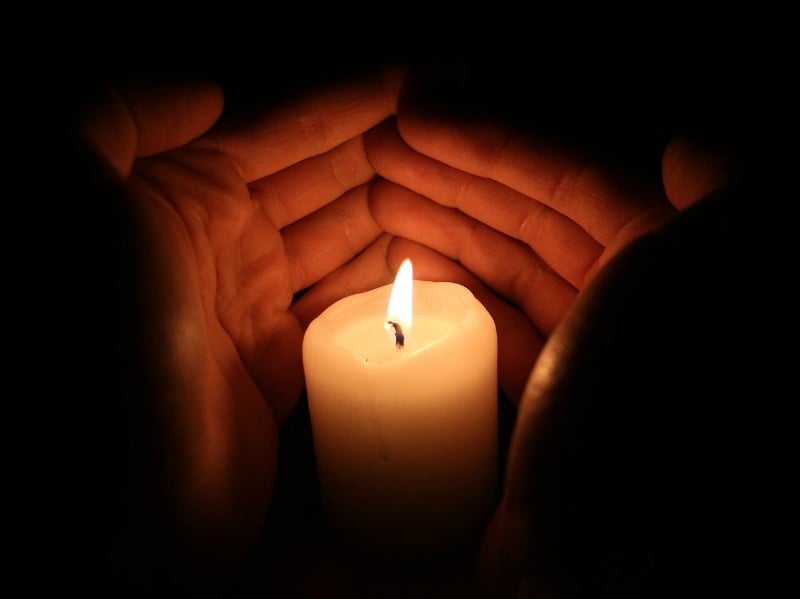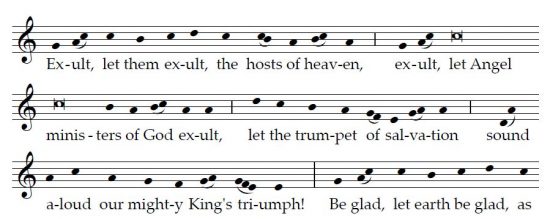 Via
Pixabay (2015), CC0 Public Domain
Via
Pixabay (2015), CC0 Public Domain
At the Easter Vigil, we are privileged to participate in the most beautiful and symbolic liturgical celebration of the Church's year. Each moment of the evening is packed with the theme of joy, from the blessing of the fire, to the baptism of the catechumens, to our own Easter Communions.
And one of the most glorious moments of the liturgy is, without doubt, the singing of the Exsultet or Easter Proclamation. This song of the Church's joy in her Risen Lord weaves together creation, salvation history, the vigil itself, and the flames of the Easter and peoples' candles, to form a tapestry of God's work in the world and our lives.
Easter, and the Exsultet, ask each of us a question I would guess many of us don't have an answer to: If Christ is truly risen, what does that mean for me? How can this historical, miraculous event change my life?
That's an intimidating question, but the Exsultet itself contains the answer, which is, of course, joy!

The very first word we hear, "Exult!" is followed by a litany of illustrative commands: let the hosts of heaven exult, the earth be glad, Mother Church rejoice. Why? Because Christ's Resurrection has filled all of creation from the farthest corners of the earth to the highest Seraphim of heaven with splendor and glory and light. We even hear "Let this holy building shake with joy, filled with the mighty voices of the peoples." Reality's joy at the Resurrection did not begin and end in 33 AD. Even now, every fiber of the natural and supernatural world rings with the overwhelming, earth-shattering truth of our dying and risen God. Which means that every day, even in the darkest days, we should let our minds and hearts embrace and be filled with that eternal gladness.
[tweet "Every day we should let our hearts be filled with Easter's eternal gladness. By @catholiclitgeek"]
A little later, we are told the story of salvation history, and hear that our very own experience of the Easter Vigil (with all the candle-fidgeting, weight-shifting, and children-juggling of a long night) is connected in some mysterious way with the night of Passover, of the Exodus, of the harrowing of Hell. "This is the night!" The final Haec nox est also provides some practical advice: "This is the night that even now, throughout the world, sets Christian believers apart from worldly vices and from the gloom of sin, leading them to grace and joining them to His holy ones." The Resurrection is supposed to make us deeply, counter-culturally different from the rest of the world. The gloom of sin should be counteracted by the joy of virtue, and each of us must be very obviously Christian so that we can share that joy with others.
There are so many gems in this canticle, but let's look at just one or two more beautiful sentences: "The sanctifying power of this night dispels wickedness, washes faults away, restores innocence to the fallen, and joy to mourners, drives out hatred, fosters concord, and brings down the mighty." That's quite the list of side-effects, isn't it? How can this be? The grace of Christ, as each of us embrace and grow in it, causes salutary effects not only in each of us but in our relationships with others. The closer we come to holiness in the risen Lord, the more we not only find our own innocence and joy, but are able to bring joy to the mourners around us and foster concord in our own families.
That same theme is continued in the paragraph that talks about the flame that is shared from the blessed fire, to the great Paschal candle, to each of our own candles: "This pillar, which glowing fire ignites for God's honor, a fire into many flames divided, yet never dimmed by sharing of its light...May this flame be found still burning by the Morning Star." The very tangible image of fire is a symbol for the love of God which should burn in each of our hearts, lit there by Christ and shared with us by our parents and godparents and priests and friends. Mother Church prays here that the light of love in each of her children's hearts may in turn "set the world on fire."
I encourage you to explore both the current, slightly shortened form of the Exsultet, available here, as well as the very long original, here. Let's let the Exsultet guide us to live a life of joy in the Resurrection for the rest of this liturgical year!
Copyright 2017 Rebecca Willen
About the Author

Rebecca W. Martin
Rebecca W. Martin, a trade book Acquisitions Editor for Our Sunday Visitor and Assistant Editor at Chrism Press, lives in Michigan with her husband and too many cats. A perpetually professed Lay Dominican, Rebecca serves as editor for Veritas, a quarterly Lay Dominican publication. Her children’s book Meet Sister Mary Margaret will release in fall 2023 from OSV Kids.


.png?width=1806&height=731&name=CatholicMom_hcfm_logo1_pos_871c_2728c%20(002).png)
Comments